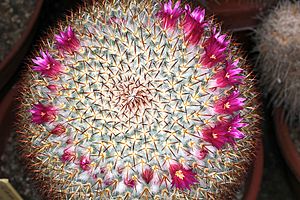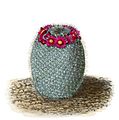Mammillaria haageana facts for kids
Quick facts for kids Mammillaria haageana |
|
|---|---|
 |
|
| Conservation status | |
| Scientific classification | |
| Genus: |
Mammillaria
|
| Species: |
haageana
|
| Synonyms | |
|
Mammillaria vaupelii Tiegel |
|
Mammillaria haageana is a fascinating type of cactus. It is known for its unique look and pretty flowers. This plant grows naturally in Mexico. It is quite common there and can be found in many different parts of the country. It belongs to a large group of cacti called Mammillaria.
Contents
What is a Cactus?
Cacti are amazing plants that can live in very dry places. They are special because they have adapted to store water. Most cacti have thick, fleshy stems that act like natural water tanks. Instead of leaves, they often have spines. These spines help protect the plant from animals. They also help reduce water loss.
How Cacti Survive in Dry Places
Cacti are masters of survival in deserts and dry regions. Their thick stems are covered with a waxy layer. This layer helps to keep water inside the plant. Their roots often spread out wide and close to the surface. This allows them to quickly soak up any rain that falls.
Spines and Their Uses
The spines on a cactus are not just for show. They serve many important purposes.
- Protection: Spines keep hungry animals from eating the juicy cactus.
- Shade: A dense covering of spines can create a bit of shade for the plant's surface. This helps to keep it cool.
- Water Collection: Some spines can help collect dew or fog. This moisture then drips down to the plant's roots.
Meet Mammillaria haageana
Mammillaria haageana is a small to medium-sized cactus. It usually grows as a single, round or cylinder-shaped stem. Sometimes, it can form clusters of stems. Its surface is covered with small bumps called tubercles. Each tubercle has a cluster of spines.
Appearance and Spines
The spines of Mammillaria haageana can vary. They are often white, yellow, or reddish-brown. Some types have very dense, soft-looking white spines. These spines almost hide the green body of the cactus. This dense spine covering helps protect the plant from strong sunlight.
Flowers and Fruits
Like many cacti, Mammillaria haageana produces beautiful flowers. These flowers usually appear in a ring around the top of the plant. They can be various shades of pink, purple, or white. After the flowers, small, red, berry-like fruits appear. These fruits often contain tiny seeds.
Where Mammillaria haageana Grows
This cactus is native to central and southern Mexico. It grows in dry, rocky areas. It can be found on hillsides and in valleys. It thrives in places with lots of sun and well-draining soil. This means the soil does not hold too much water.
Its Natural Habitat
In its natural home, Mammillaria haageana often grows alongside other desert plants. These include other cacti, succulents, and hardy shrubs. It is well-adapted to the hot days and cool nights of its environment. It can handle periods of drought very well.
Life Cycle and Reproduction
The life cycle of Mammillaria haageana starts with a tiny seed. When conditions are right, the seed sprouts. It grows into a small seedling. Over time, it slowly grows into a mature cactus.
How New Plants are Made
Mammillaria haageana can reproduce in a few ways:
- Seeds: The most common way is through seeds. Birds or other animals might eat the fruits and spread the seeds.
- Offsets: Some Mammillaria species can produce small "baby" cacti, called offsets or pups. These grow from the base of the main plant. They can break off and start new plants.
Cacti in Our World
Cacti like Mammillaria haageana are important parts of their ecosystems. They provide food and shelter for various animals. Their flowers attract pollinators like bees and hummingbirds.
Conservation Status
Mammillaria haageana is listed as "Least Concern" by the IUCN. This means it is not currently in danger of extinction. However, it is always important to protect natural habitats. This ensures that all plants and animals can continue to thrive.
Gallery
See also
 In Spanish: Mammillaria haageana para niños
In Spanish: Mammillaria haageana para niños






